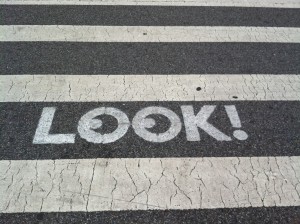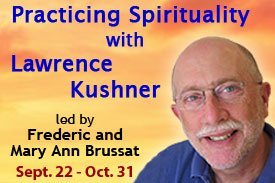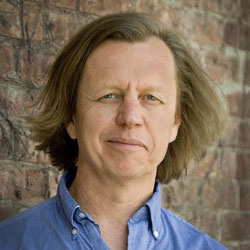
It happens all the time. A song comes on the radio, and we hear a lyric in a new way. We notice an interesting sign while walking in the city – like “Look” at a crosswalk. We’re paging through a book or browsing the Internet and a picture catches our eye. We pass a playground and remember a childhood game.
What if these are signs? What if they are messages from the Divine?
We talk a lot about spiritual literacy in this blog, and here’s how we define it: “Spiritual literacy is the ability to read the signs written in the texts of our own experiences.” We think it is both a gift from God and a skill that can be cultivated. Indeed, that’s one of the purposes of spiritual practices: to help us become more spiritually literate.
We’ve have some good mentors as we’ve trained ourselves to read the signs. One of them is Rabbi Lawrence Kushner. He has a real knack for finding the wisdom in the events of daily life. For example, remember that dance we did in grade school, the Hokey Pokey? Here’s Kushner writing about it in his book Invisible Lines of Connection.
“There used to be this dance we did in junior high school. It was a ‘mixer,’ that’s a euphemism for everybody could do it. Dweeby kids, dorky kids, nerdy kids and popular kids – like you and me. Everyone formed a big circle. There was someone in the center (usually an English teacher) who led it. She would say, ‘You put your right hand in, you take your right hand out, you put your right hand in and you shake it all about.’ For those of you from Mars, the dance was called the Hokey Pokey. It went on like that, each time featuring a different part of the human anatomy. There are a lot of parts. And young adolescents take great pleasure in shaking them, especially while they are surreptitiously watching what other young adolescents look like while they are doing the same thing. The dance ended with everyone complying with and singing the final instruction: ‘You put your whole self in, you take your whole self out. You put your whole self in and you shake it all about. You do the Hokey Pokey, and you shake yourself about. And that’s what it’s all about.’
“So that’s what it’s all about! You put your whole self in, you take your whole self out; you put your whole self in and you shake it all about. The idea is that by doing whatever you’re doing with all of you, you can then take all of you out. The trick is how to do both.
“It is possible to put your whole self into many things that are gratifying, beautiful and even important but which, in retrospect, we realize are not what it’s all about. We confuse the great and transforming joy that usually accompanies life’s milestones with being what it’s all about. This is because they are so intense that we must put our whole self into them. But if we allow them to become the goal, then they are only diversions. Putting your whole self in and shaking it all about is important (and usually a lot of fun, too) but it is not enough. You also have to take your whole self out. You must also go beyond your self, transcend your self.”
When we read something like this, we are not only inspired, we are motivated to find a way to practice this thought. We ask ourselves things like, Where do I put my whole self into what I’m doing? Where don’t I and why? Where can I be fully engaged today? When I am, why am I so involved? Am I seeking attention? Does my ego need this? Or can I easily pull my ego out of it? What does it mean for me to transcend my self?
And there is another step beyond thinking about this idea. We have to practice it in some activity we are doing today: putting our whole selves in and then taking our whole selves out. Where could you do that today?
This process that we’ve just gone through is what we do in the “Practicing Spirituality” series of e-courses we offer at SpiritualityandPractice.com. We take a short reading and use it to create a spiritual practice.
These 40-day programs consist of daily emails each with a short passage from a spiritual book and a way to practice that thought as you go through your daily activities. Then e-course subscribers are invited to come to an online forum (we call it a Practice Circle) to share their responses to the reading and their experience with the practice suggestion.
We are starting a new one of these e-courses next week, Sunday, September 22: Practicing Spirituality with Lawrence Kushner. (It’s not too late to sign up for this e-course. Once you register, you’ll find any emails that have already gone out archived on your account page at Spirituality & Practice.) Read more about this e-course, including sample themes, and sign up on this page.
We hope you join us as we learn to read the signs in our daily life!












